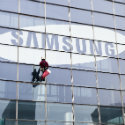
A 5G deal with Verizon valued at $6.6 billion will establish Samsung as one of the main suppliers of radio equipment to the operator that is still North America's largest.
Following recent speculation Verizon was courting Samsung as a replacement for Nokia, it also bodes ill for the struggling Finnish vendor.
Other than the contract value and timeframe, Samsung provided few details in a short regulatory filing published on its website this morning: Signed on Friday, the deal runs until the end of 2025 and is therefore worth about $1.2 billion annually.
That is about 7% of what Sweden's Ericsson makes each year in network sales. Samsung, moreover, was quick to note the entire 5G contract equals 3.43% of its annual revenues. 5G awards do not come much bigger.
Unsurprisingly, Samsung's share price rose 1.62% in South Korea today after the public disclosure.
Better known for its chips and line-up of consumer electronics, the company has been trying to position itself as a 5G networks alternative to Ericsson, Nokia and Huawei, a Chinese vendor out of favor in Western markets.
The Verizon deal is further proof that major carriers outside Samsung's domestic market now take it very seriously.
It could also boost Samsung's presence in the equipment sector.
Last year, the company accounted for just 3% of all telecom equipment sales, according to Dell'Oro, a market-research firm.
Huawei had a 28% share, while Nokia and Ericsson claimed 16% and 14% respectively.
While Samsung does not break out its network sales, they came to about $3 billion in 2019, according to Light Reading's estimates.
Annualized, the latest 5G contract equates to more than one third of that amount.
Obvious choice
Samsung is clearly a more obvious choice for US operators than it is for service providers in some other regions.
During the 4G era, many European carriers gorged on "single RAN" products developed by Huawei. These allowed them to run 2G, 3G and 4G services over the same technology platform, minimizing costs.
But they also mean operators now replacing Huawei need vendors that can support 2G and 3G services. Samsung lacks the requisite expertise. For that reason, the UK's BT has ruled it out as a Huawei substitute.
The South Korean vendor has also pumped more investment into the US, where the long-running absence of Chinese suppliers brings opportunity.
"It was widely expected that Samsung would win market share in US mobile infrastructure," says Gabriel Brown, a principal analyst with Heavy Reading, Light Reading's sister company.
"It has invested in the region for a long time, and has been making steady gains. With the 5G cycle it now has the technology, products and in-market presence to expand share."
Nokia's recent 5G product difficulties might also explain Verizon's choice of Samsung. The Finnish vendor acknowledged its problems a year ago and is now shifting from costly, programmable chips to more profitable, customized ones in its 5G hardware.
Want to know more about 5G? Check out our dedicated 5G content channel here on Light Reading.
In July, Ryan Koontz, an analyst with Rosenblatt, said Verizon was close to replacing Nokia with Samsung as a major 5G supplier next to Ericsson. His prediction that it would land a contract worth up to $1.5 billion annually, for five to seven years, was nearly bang on the mark.
Nokia furnished Light Reading with a somewhat cagey statement in response to today's announcement.
"Nokia's relationship with Verizon remains strong and strategic," said a spokesperson in emailed comments.
"We are proud to support them and are committed to help them build the best, most reliable and highest-performing network."
"We play a critical role in enabling Verizon's 3G and 4G networks and continue to work with them to accelerate innovation in 5G," added the company.
"They remain a top three global customer and our strategic partnership includes a wide range of areas such as radio access, IP routing, software, fixed networks, services and more."
Opening up?
Nokia's insistence it remains a critical part of Verizon's 3G and 4G systems suggests the operator might use a so-called "overlay" to introduce Samsung without ditching its Finnish rival.
BT, Vodafone and many other European operators say they must buy their 4G and 5G products from the same vendor to maximize performance.
An overlay alternative, promoted by Samsung, would take advantage of an interface called X2 to support handover between 4G equipment from one vendor and 5G gear from another.
Whatever the performance downsides, this could allow Verizon to avoid a costly swap-out of Nokia's 4G equipment.
That would mark a step toward a more open and "disaggregated" network, whose components are supplied by a multitude of vendors.
Networks based on open RAN technology, which opens the interfaces between different parts of the radio access network, are increasingly seen as the way to inject competition into a market dominated by one Chinese and two Nordic vendors.
Both Samsung and Nokia have recently boasted compatibility with open RAN specifications. Yet neither has had much to shout about commercially so far.
Regardless of open RAN, Verizon is likely to have been attracted to Samsung's widely recognized expertise in several 5G areas – something the South Korean vendor was eager to highlight in its own statement on the deal.
"Samsung is a pioneer in mmWave, sub-6 [GHz] and virtualized RAN innovation, and a leader in end-to-end 5G solutions – from chips to networks to devices," said a spokesperson.
5G growth will undoubtedly be harder for Samsung in other parts of the world. But the telco need for muscular alternatives to Ericsson, Huawei and Nokia puts the South Korean behemoth in a strong position.
A multi-billion-dollar deal with one of the world's largest operators will certainly raise its profile.
Related posts:
— Iain Morris, International Editor, Light Reading
About the Author(s)
You May Also Like




_International_Software_Products.jpeg?width=300&auto=webp&quality=80&disable=upscale)







